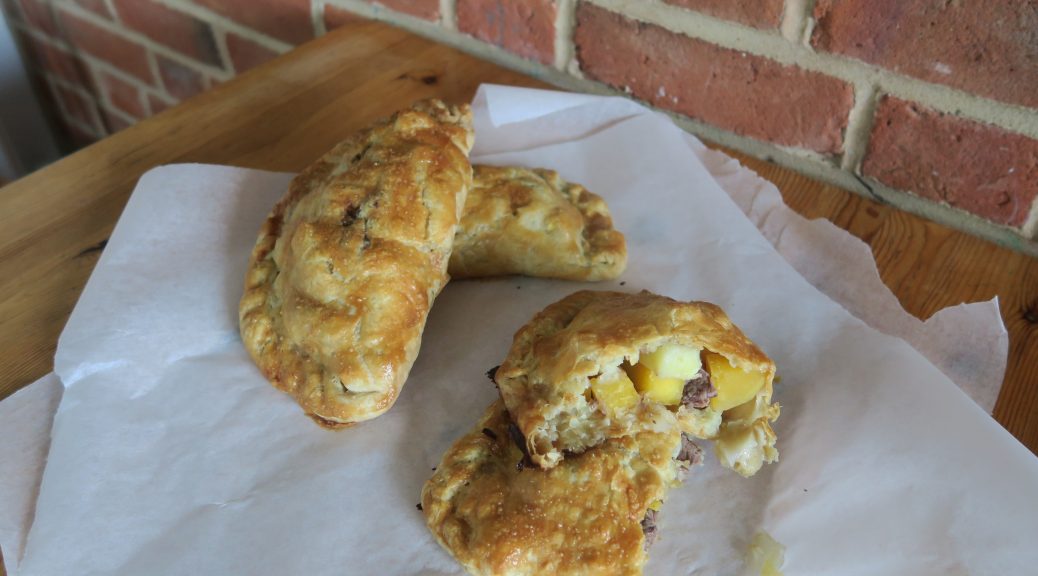
Cornish Pasties
So back into the south for some inspiration this week. It’s kind of a necessity to eat a pasty at some point when you’re in the West-country, and though there’s dozens of kinds out there for the picking, a good old Cornish pasty will always be my favourite. When I think of pasties I think of wandering barefoot along the beach with a warm, slightly over-flowing pasty in hand. Flakes of buttery pastry flying into your face in the wind, and shooing off seagulls left, right and centre. This might not paint the most relaxing experience of dining there is, but it’s rough, rustic and nostalgic which is what I love most about it.

I know that quite often people hate pasties because they’re thought of being greasy and stodgy. These homemade ones are a lot cleaner than you’d think, and the rough-puff pastry is way lighter than the stuff you find on traditional pasties. The key is to make sure you season the filling A LOT as it’ll totally transform the flavour of the pasty and make it really moreish. Traditionally beef skirt is used to fill a pasty as it releases gorgeous juices that taste amazing. That said, beef skirt is almost impossible to find in a local supermarket, so if you can’t find it I’d recommend using frying steak, escalopes or any cut of beef that’s relatively thin.

Recipe
Makes 6
Time: 90 minutes, plus chilling
Ingredients
For the pastry
- 450g Strong bread flour
- Large pinch of salt
- 100g Cold, unsalted block butter
- 100g Cold lard
- 200ml Cold water
For the filling
- 200g Potatoes
- 1 Small onion
- 100g Swede (1 small)
- 200g Lean beef skirt (or frying steak if you can’t find beef skirt)
- Salt and pepper to season
- 1 Beaten egg
Method
- Begin by making the pastry. Put the flour and salt into a large bowl. Then take the chilled blocks of lard and butter and grate them into the butter. I’d recommend giving everything a little mix regularly as you do the grating so that the fats can be coated in flour, this will stop them all re-forming into a lump when you mix it all together.
- Then take a round-bladed knife and mix the fat into the flour so it’s all coated. Pour the cold water into the bowl and continue to mix to form a soft dough.
- Tip the dough out onto a surface and knead a little to bring the dough together into a ball. Wrap the pastry in cling film and chill in the fridge for at least 30 minutes.
- Now prep the filling. Peel the potatoes, onions and swede. Then chop the potato into chunks, about the thickness of a £1 coin. Then finely chop the onion, and chop the swede into chunks the same size as the potato.
- Now prep the meat. Using a sharp knife remove any gristle from the meat, but leave the fat as it’ll add great flavour to the pasty. Then chop the meat into chunks about the same size as the potato.
- Pre-heat the oven to 180˚C.
- Split the pastry into 6 and then roll each one out to a 14cm diameter circle. Using a plate as a stencil can be helpful here to get a neat circle.
- Distribute the onions between the pastry discs, spreading them in a semi-circle over one half of the dough, leaving a 1 cm boarder around the edge for sealing. Sprinkle over a little salt and pepper. Then top with a layer of swede, then meat and finally potato, seasoning a little between each layer.
- Take a cup of water and dip your finger into it. Then moisten the rim of the pastry circle with your finger. Fold the unfilled half of the pastry over the filling and use the edge of your hand to gently seal the pastry.
- Now it’s time for the crimping that’ll keep the pastry together. Working from right to left fold the pastry over itself and then press down. Repeat along the seam of the pasty to make a rope pattern until you reach the end.
- Put the pasties onto a baking tray and brush with the beaten egg. Bake for 15-20 minutes until golden brown, then reduce the oven temperature to 160˚C and continue to bake for 15 minutes. Then turn off the heat and leave the pasties to cool/keep cooking in the oven for another 30 minutes. Serve!

Thanks for reading!
Emma x